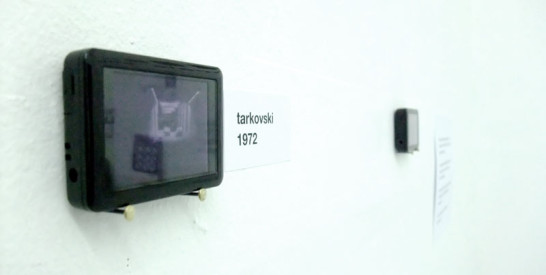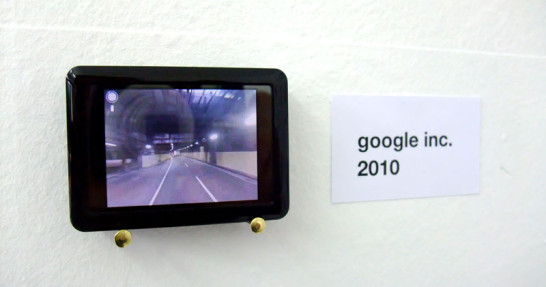I recently used the “iriver Lplayer” portable video player as an exhibition display (see this post). Here are some rough technical notes about the usage of this device. This model of mp3/mp4/player was released in 2008, and is currently still available for a modest price in many online stores. It comes with 4gb of storage, and most importantly, it has a very slick and minimal design, that makes it perfect for exhibition displays.

Technicalities:
The screen of the Lplayer gives a quite enjoyable video quality (at 320×240 video resolution, 4:3 screen ratio). The battery duration covers several hours of playback (enough for the duration of a gallery opening). When plugged to electricity via an USB adapter, you can put the device in “charge and play” mode. If you play a video in loop mode, it will play reliably for days. I left the device in the gallery window for about five days, and it was still playing on my return.
Issues:
Issue #1: video encoding.
Encoding a video in the proper format for this device is insanely complicated. Actually I almost gave up, and it took me hours of research to finally come up with a solution. According to the user manual, the player is able to play video files in AVI/mpeg4 format, as well as in WMV format. Having my files in mov/mpeg4 format, it’s of course needed to re-encode them first. The iriver “Movie Converter” software (windows-only) that comes with the device supposedly should handle the re-encoding. Unfortunately, it’s unable to recognize any codec known to mankind – h264, h263, sorenson, MPEG1, mjpeg… all are unknown to the iRiver encoder, it will say “Conversion failed because codec doesn’t exist” (while every other video soft is able to read/convert the files).

The user manual indicates that the video must be AVI, MPEG4 SP (simple profile), at 320×240, or in WMV. Analyzing the videos already present on the device (with the help of MediaCoder 0.7.2), I notice that they are encoded with the XviD codec (1.1.2). The writing application is MEncoder (1.0rc1-3.4.4). This increases my motivation to find a solution to this puzzle…
Sidenote: using a sample WMV movie, I notice that the iriver transfer software does accept it, BUT while copying it to the device, it re-encodes it into mpeg4/AVI. This is a scenario i will try to avoid – encoding my MPEG4/MOV files into WMV, to re-encode them back to MPEG/AVI is simply too absurd.
The mysterious world of Windows video software…
The next step is to browse the Internet for resources. Search for “video converter iriver”, and you will notice that there are dozens of applications that pretend to do this job — most of them coming from strangely similar-looking sites that advertise similar-looking software boxes (with such hyper-original names as “Video Converter”, “iRiver Video Converter”, “Video to MP4 Converter”, “Total Media Converter”, “VideoConverterPro”…).
Since my multimedia activity is mostly occurring far away from Windows, I was unaware until now of this gigantic grey zone of conversion tools — an army of parasitic mushroom software growing in the shadow of closed platforms and proprietary media formats. DVD to WMV to AVI to FLV to 3GP conversion anyone?
Even more strange: many of those companies, even if the site design and names are different, appear to be selling the same software over and over: just have a look at 4Easysoft.com, aimersoft.com, iskysoft.com, wondershare.com, and you will feel trapped in a maze of mirrors.
Needless to say, you shouldn’t waste your time with any of those applications. While some of them manage to produce an XviD/AVI file that apparently matches the iriver specs, all of them produce the same error message on the player.
What works: iriverter
Finally, I come across a tool that looks much more promising:
http://iriverter.thestaticvoid.com/
Described as a “cross-platform frontend to mencoder”, and created by “a 23-year-old Unix sysadmin and grad student at GWU”, this simple software manages to encode the files in a flavor of XviD that fits Lplayers taste.
The encoding setting that you need to select:
Options > Device > iriver > 4 – clix / U10
Issue #2 – launching the video.
Even when encoded in the proper format, when launching one of my files, the device will often say that the “codec is not supported”. The workaround: start playing one of the pre-installed demo files (hopefully you didn’t delete them); stop; go back; play your video — the device now plays it without complaining. This peculiar behavior is consistent and repeatable.
Issue #3 – looping the video.
Being able to play the video is one thing, but you also need to be able to put it in “repeat” mode. While this setting was available on one device, I spent a good time searching for that non-existing menu on others. The trick is: out of the box, your device may have an older firmware version (1.03) where the “Play Mode” setting isn’t available. So, before you can use the device in loop mode, you need to update the firmware to the newest version (1.06). To verify the firmware of your player, go into Settings > Advanced > System Information.
What you need in order to update the firmware:
1) a computer running Windows :(
2) the original iriver software (it will propose you a firmware update as soon as you connect the device).
3) an internet connection.
4) lots of patience for watching the progress bar move a few % per minute (the operation takes about 20 minutes – i wonder what’s the filesize of that firmware ?!!).
Once you finished those steps, you’re ready to go. I hope those instructions will be useful for somebody out there. Have fun with your Lplayer!